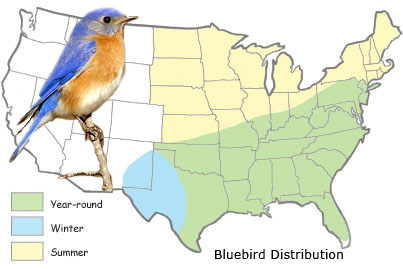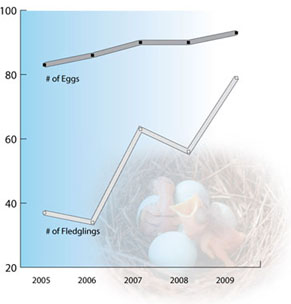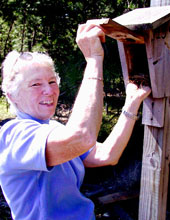Bluebirds
 The Eastern bluebird was once a common species along the east coast of the United States. But due to habitat loss and the introduction of aggressive non-native birds, such as the House sparrow, the bluebird population dwindled from mid-1930 through the 1970's. Since the 1970's, bluebird enthusiasts have built and monitored bluebird trails and the population steadily increased. Bluebirds are now nesting successfully in areas where they had been missing for 25 years.
The Eastern bluebird was once a common species along the east coast of the United States. But due to habitat loss and the introduction of aggressive non-native birds, such as the House sparrow, the bluebird population dwindled from mid-1930 through the 1970's. Since the 1970's, bluebird enthusiasts have built and monitored bluebird trails and the population steadily increased. Bluebirds are now nesting successfully in areas where they had been missing for 25 years.
Distribution and habitat
The Eastern bluebird (Sialia sialis) prefers to inhabit open fields or grassy areas scattered with trees; such as field edges, hedgerows, or roadsides. This species can be found anywhere east of the Rocky Mountains all the way to the Atlantic coast.
FREC Bluebird Eggs and Fledglings
2005–2009
Nesting
Bluebirds nest in naturally existing tree cavities or in nestboxes. Nestboxes should be installed approximately five feet off the ground. Other birds such as the chickadee, house sparrow, tree swallow, and house wren may also use bluebird houses.
Bluebirds construct nests of fine grasses and pine needles. The female lays one egg a day for a total of 1-6 eggs per clutch. Most of the time the eggs are pale blue, but they may also be white. The female bluebird sits on the eggs to keep them at 94° until they hatch in 12-14 days. The hatchlings stay in the nest for another 15-20 days before fledging. Bluebirds can have up to three clutches per season from March to September.
FREC Bluebird Monitor

NJFS volunteer Laura Stone monitors the Bluebird Trail at the Forest Resource Education Center. Through the spring and summer, she diligently monitors 39 nest boxes. Laura records the number of nests, eggs, young, and fledglings in each box. She sometimes encounters more than birds - everything from blowflies and wasps to snakes and bats have been found in the nest boxes. Despite these obstacles you will find Laura at the FREC once a week, clipboard in hand, cautiously opening each box.
Learn more about bluebirds with our Bluebird Nestbox Trail guide. [pdf 367K]
 The Eastern bluebird was once a common species along the east coast of the United States. But due to habitat loss and the introduction of aggressive non-native birds, such as the House sparrow, the bluebird population dwindled from mid-1930 through the 1970's. Since the 1970's, bluebird enthusiasts have built and monitored bluebird trails and the population steadily increased. Bluebirds are now nesting successfully in areas where they had been missing for 25 years.
The Eastern bluebird was once a common species along the east coast of the United States. But due to habitat loss and the introduction of aggressive non-native birds, such as the House sparrow, the bluebird population dwindled from mid-1930 through the 1970's. Since the 1970's, bluebird enthusiasts have built and monitored bluebird trails and the population steadily increased. Bluebirds are now nesting successfully in areas where they had been missing for 25 years.




